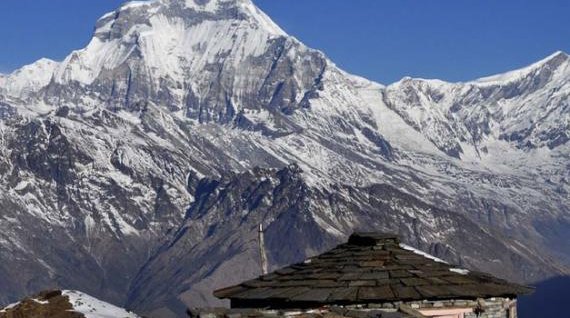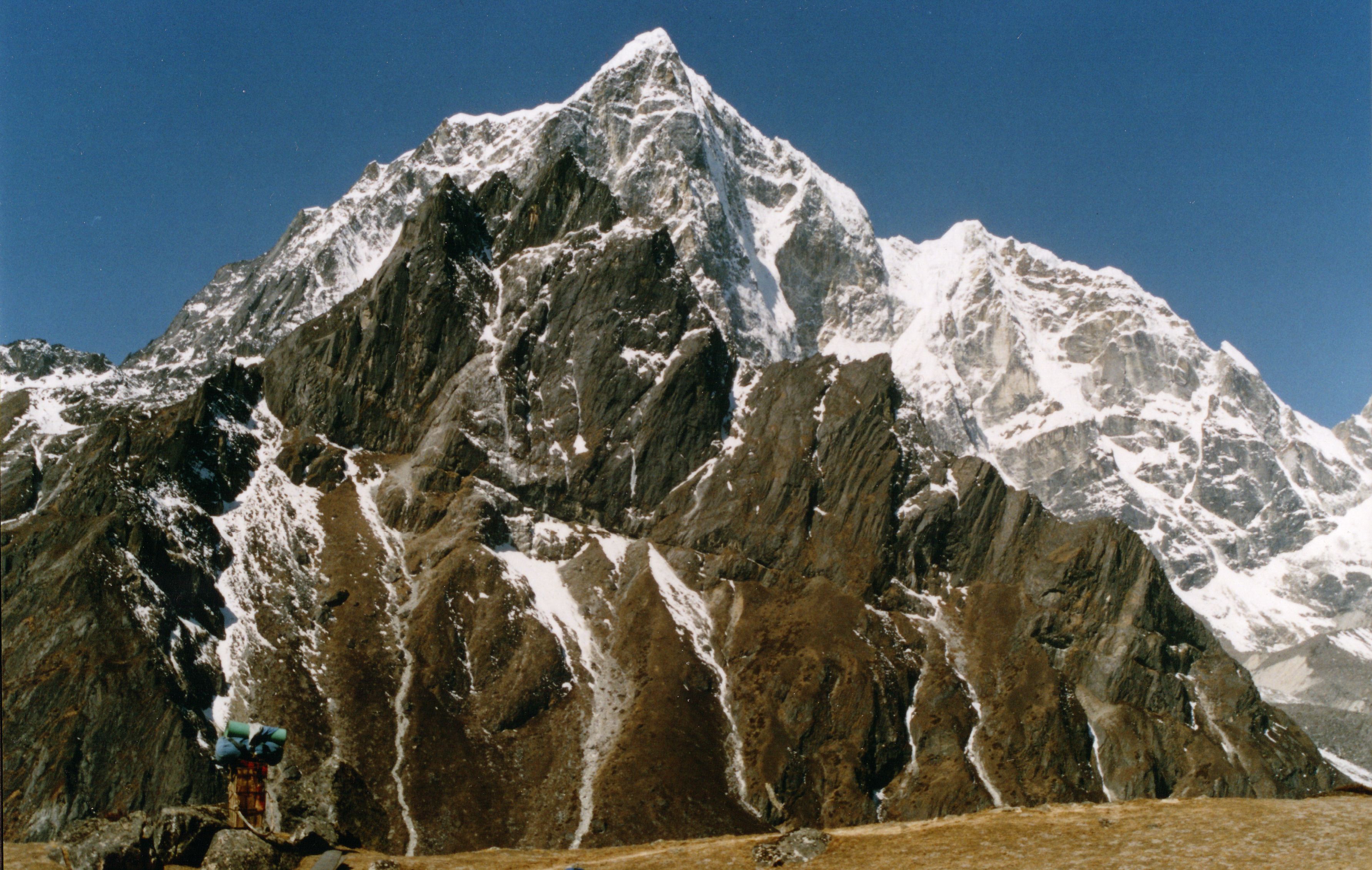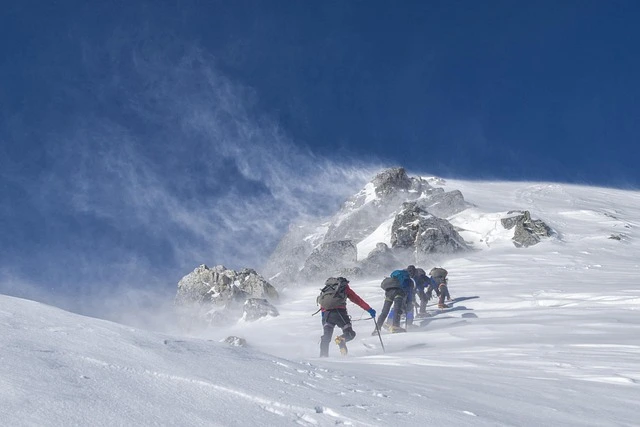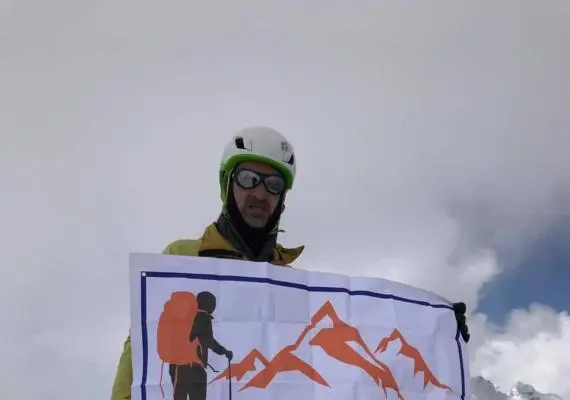Picture yourself standing on a remote Himalayan ridge at sunrise, watching golden light paint the massive faces of Dhaulagiri and Annapurna South. The Khopra Ridge trek, also known as the Annapurna Dhaulagiri trek, takes you far from the crowded trails into authentic Gurung villages where traditional life continues unchanged. This community-based trek offers spectacular mountain views without the tourist masses, making it perfect for travelers seeking genuine cultural experiences alongside stunning Himalayan scenery.
Unlike the busy Annapurna Base Camp route, this off-the-beaten-path adventure combines moderate difficulty with extraordinary rewards. You'll sleep in community lodges run by local families, trek through rhododendron forests that explode with color in spring, and reach viewpoints that rival any in Nepal. The trek typically takes 10-15 days, depending on your chosen route, with the highest point at Khayer Lake reaching 4,600 meters.
Trip Highlights
- 360-degree mountain panorama from Khopra Ridge including Dhaulagiri (8,167m), Annapurna South (7,219m), and Machhapuchhre
- Sacred Khayer Lake at 4,600m with crystal-clear waters and mountain reflections
- Authentic Gurung villages of Ghandruk, Swanta, and Nangi with traditional architecture
- Community lodge experience supporting local families directly
- Rhododendron forests blooming red, pink, and white (March-April)
- Mohare Danda sunrise viewpoint with views of 20+ peaks
- Less crowded trails compared to main Annapurna routes
- Wildlife spotting including Himalayan tahr, langur monkeys, and diverse birdlife
Annapurna Dhaulagiri Trek 15-Day Itinerary
Day 1: Kathmandu to Pokhara
- Transport: 6-7 hour drive (or 25-min flight)
- Altitude: 820m
- Stay: Pokhara lakeside
Day 2: Pokhara to Ghandruk
- Drive: 1.5 hours to Nayapul
- Trek: 4-5 hours uphill
- Altitude: 2,012m
- Highlights: Gurung village, mountain views
Day 3: Ghandruk to Tadapani
- Trek: 3-4 hours
- Altitude: 2,630m
- Trail: Through oak and rhododendron forest
Day 4: Tadapani to Dobato
- Trek: 4-5 hours
- Altitude: 3,420m
- Feature: Dense rhododendron forest
Day 5: Dobato to Upper Chistibung
- Morning: Sunrise at Muldai Viewpoint
- Trek: 5-6 hours
- Altitude: 3,050m
- Views: 360-degree mountain panorama
Day 6: Upper Chistibung to Khopra Ridge
- Trek: 3-4 hours
- Altitude: 3,660m
- Highlights: Exposed ridge walk, prayer flags
Day 7: Khayer Lake Day Trip
- Duration: 7-8 hours round trip
- Max altitude: 4,600m
- Feature: Sacred alpine lake
Day 8: Rest Day at Khopra Ridge
- Activities: Acclimatization, photography
- Views: Dhaulagiri, Annapurna South
Day 9: Khopra Ridge to Swanta
- Trek: 5-6 hours descent
- Altitude: 2,270m
- Village: Traditional Magar community
Day 10: Swanta to Ghorepani
- Trek: 4-5 hours
- Altitude: 2,860m
- Note: Join main Annapurna trail
Day 11: Poon Hill and Descent
- Sunrise: Poon Hill (3,210m)
- Trek: 6-7 hours to Nayapul
- Drive: Return to Pokhara
Day 12-13: Pokhara
- Day 12: Rest and explore
- Day 13: Free day for activities
Day 14: Return to Kathmandu
- Transport: 6-7 hour drive
Day 15: Departure
- Airport transfer and flight home
Quick Facts:
- Total trekking days: 9
- Highest point: Khayer Lake (4,600m)
- Difficulty: Moderate
- Best seasons: Spring (Mar-May) and Autumn (Oct-Nov)
Why Choose the Khopra Ridge Trek?
The Annapurna Dhaulagiri Community trek stands apart from other Nepal treks for several reasons. First, you're directly supporting local communities through the community lodge system. These aren't just teahouses – they're family homes where villagers have opened rooms to provide sustainable income.
The trek difficulty hits the sweet spot for most hikers. You don't need technical climbing skills, but you'll feel accomplished reaching Khopra Ridge at 3,660 meters. The altitude is manageable compared to Everest Base Camp, yet high enough for spectacular views.
What really sets this trek apart is the perfect balance of nature and culture. One day you're walking through dense rhododendron forests, the next you're sharing dal bhat with a Gurung family while learning about their traditions. The mountains feel closer here than on busier routes, with Dhaulagiri's massive south face dominating the horizon.
Best Time for Khopra Ridge Trek
Spring Season (March-May)
Spring brings the famous rhododendron blooms to the Annapurna region. The forests between Tadapani and Dobato transform into a natural garden with red, pink, and white flowers. Weather stays mostly clear with excellent mountain visibility. Temperatures are comfortable – warm days and cool nights.
Autumn Season (September-November)
After monsoon clears, autumn offers the clearest mountain views of the year. The air is crisp and visibility extends for hundreds of kilometers. This is peak trekking season, though Khopra Ridge remains less crowded than mainstream routes. Festival season adds cultural richness to village experiences.
Winter Trekking (December-February)
Khopra Ridge trek in December presents unique challenges and rewards. Snow covers higher sections creating pristine landscapes. Community lodges stay open but bring extra warm gear. The solitude is incredible – you might have the entire ridge to yourself. Clear days offer unbeatable mountain views.
Monsoon Considerations (June-August)
Most trekkers avoid monsoon, but it's actually possible with proper rain gear. Leeches appear on lower trails and views get obscured by clouds. However, the landscape turns brilliantly green and wildflowers bloom everywhere. Lodges offer discounts and you'll experience authentic village life without tourist crowds.
Detailed Route Description
Starting Point: Ghandruk Village
Your Khopra Danda trek typically begins in Ghandruk, the largest Gurung village in Nepal. Stone-paved paths wind between traditional houses with carved wooden windows. The Gurung Cultural Museum provides context for your journey. From here, you'll climb steadily through terraced fields toward the tree line.
The Climb to Tadapani
Leaving Ghandruk, the trail ascends through mixed forests of oak, rhododendron, and bamboo. Tadapani means "far water" in Nepali, named for its distant water source. This ridge-top settlement offers the first panoramic mountain views including Annapurna South and Machhapuchhre.
Dobato and Muldai Viewpoint
The path to Dobato passes through some of Nepal's most beautiful rhododendron forests. In spring, these ancient trees create natural tunnels of flowers. Muldai Viewpoint, a short detour from Dobato, rewards early risers with sunrise views across the entire Annapurna range.
Reaching Khopra Ridge
The final approach to Khopra Ridge trek follows an exposed ridge with dramatic drops on both sides. Prayer flags mark the arrival at this sacred viewpoint. The community lodge here, built through local initiative, provides basic but comfortable accommodation at 3,660 meters.
Khayer Lake Excursion
The challenging day trip to Khayer Lake tests your fitness and acclimatization. This sacred lake sits in a natural bowl surrounded by peaks. Hindu and Buddhist pilgrims journey here during full moon festivals. The altitude of 4,600 meters requires slow, steady pacing.
Accommodation on the Annapurna Dhaulagiri Trek
Community Lodge Experience
Community lodges differ from commercial teahouses in meaningful ways. Local families manage these lodges collectively, sharing profits for community development. Rooms are simple but clean with thick blankets for cold nights. Most have shared bathrooms with basic facilities.
What to Expect
- Rooms: Twin beds with mattresses and blankets
- Bathrooms: Shared squat toilets, bucket showers (hot water available for small fee)
- Dining: Communal dining room with wood stove for warmth
- Electricity: Solar power for charging (small fee applies)
- WiFi: Limited or no internet above Ghandruk
Food on the Trail
The menu at community lodges focuses on local ingredients. Dal bhat (rice, lentils, vegetables) provides unlimited refills and sustained energy. Other options include:
- Tibetan bread with honey or jam
- Vegetable or egg fried rice
- Noodle soup (thukpa)
- Momos (dumplings)
- Chapati with curry
- Porridge for breakfast
Khopra Ridge Trek Difficulty and Fitness Requirements
Overall Difficulty Rating
The Annapurna Dhaulagiri trek rates as moderate to moderately challenging. You'll walk 4-7 hours daily on varied terrain including steep ascents, stone steps, and occasional exposed sections. The highest overnight stay at Khopra Ridge (3,660m) rarely causes severe altitude problems.
Physical Preparation
Start training at least 6-8 weeks before your trek:
- Cardiovascular fitness: Regular hiking, running, or cycling
- Leg strength: Stair climbing, squats, lunges
- Core stability: Planks and balance exercises
- Practice hikes: Weekend hikes with loaded backpack
Daily Challenges
- Day 3-4: Steep climb from Ghandruk to Dobato
- Day 6: Final ascent to Khopra Ridge on exposed trail
- Day 7: Long day to Khayer Lake with 900m elevation gain
- Day 9: Steep descent to Swanta Village
Cultural Experiences Along the Trail
Gurung Heritage
The Gurung (Tamu) people have inhabited these hills for centuries. Their warriors famously serve in Gurkha regiments worldwide. In villages like Ghandruk and Swanta, you'll see traditional round houses with thatched roofs, though many now use tin roofing.
Village Life
Morning starts with roosters crowing and buffalo bells ringing. Women carry impossible loads of grass for livestock. Children walk hours to school in neat uniforms. Evenings bring everyone together around kitchen fires where stories flow with raksi (local alcohol).
Festivals and Traditions
If your trek coincides with local festivals, you're in for special treats:
- Dashain (September/October): Nepal's biggest festival
- Tihar (October/November): Festival of lights
- Lhosar (February): Gurung New Year
- Buddha Jayanti (May): Buddha's birthday
Permits and Regulations
Required Permits for Khopra Ridge
- Annapurna Conservation Area Permit (ACAP)
- Cost: NPR 3,000 (about $25 USD)
- Valid for single entry
- Available in Kathmandu or Pokhara
- TIMS Card (Trekkers Information Management System)
- Green card (individual trekkers): NPR 2,000
- Blue card (group trekkers): NPR 1,000
- Requires passport copy and photos
Where to Get Permits
- In Kathmandu: Nepal Tourism Board office in Bhrikutimandap
- In Pokhara: Tourism office near Lakeside
- Through agencies: Most trekking companies handle permits
New Regulations
Recent rules require hiring licensed guides for solo trekkers. This supports local employment and enhances safety. Budget an extra $25-30 per day for guide services.
Safety and Acclimatization
Altitude Considerations
While Khopra Ridge trek doesn't reach extreme altitudes, proper acclimatization remains important:
- Climb slowly, especially above 3,000 meters
- Stay hydrated (3-4 liters daily)
- Avoid alcohol during ascent days
- Consider rest day at Khopra Ridge
- Descend immediately if symptoms worsen
Common Altitude Symptoms
- Mild headache
- Slight nausea
- Difficulty sleeping
- Loss of appetite
- Fatigue
Emergency Procedures
- Helicopter evacuation possible from most villages
- Basic health posts in Ghandruk and Ghorepani
- Communication available via lodges' phones
- Travel insurance with evacuation coverage essential
Wildlife and Natural Beauty
Flora Along the Trail
The trek passes through diverse ecological zones:
- Lower elevations: Terraced farmland, banana trees
- Mid-elevations: Oak and rhododendron forests
- Higher zones: Alpine shrubs, medicinal plants
- Above treeline: Hardy grasses and wildflowers
Wildlife Spotting
Early mornings and late afternoons offer best wildlife viewing:
- Himalayan tahr: Sure-footed wild goats on steep slopes
- Langur monkeys: Black-faced primates in forest areas
- Birds: Over 200 species including colorful pheasants
- Rare sightings: Red panda, Himalayan black bear (very rare)
Photography Tips
Best Photo Opportunities
- Muldai sunrise: Arrive 30 minutes before dawn
- Khopra Ridge panorama: Golden hour provides best light
- Khayer Lake reflections: Calm mornings ideal
- Village life: Ask permission before photographing people
- Rhododendron forests: Macro lens for flower details
Equipment Considerations
- Extra batteries (cold drains power)
- Lens cleaning cloth for dust
- Weatherproof camera bag
- Lightweight tripod for sunrise shots
- Backup memory cards
Environmental and Cultural Responsibility
Leave No Trace Principles
The pristine beauty of Khopra Ridge depends on responsible trekking:
- Pack out all trash including organic waste
- Use designated toilet facilities
- Stay on marked trails
- Respect wildlife viewing distances
- Avoid single-use plastics
Supporting Local Communities
Your trek directly benefits villages when you:
- Stay in community lodges
- Buy handicrafts directly from makers
- Hire local guides and porters
- Eat local food
- Participate respectfully in cultural exchanges
Photography Ethics
- Always ask before photographing people
- Respect sacred sites and ceremonies
- Don't give money for photos
- Share photos with subjects when possible
- Avoid drone use near villages
Final Preparations
Two Weeks Before Departure
- Confirm all bookings
- Check passport validity (6 months required)
- Arrange travel insurance
- Start taking altitude medication if prescribed
- Break in new boots
- Test all gear
Health Precautions
- Visit travel clinic for vaccinations
- Pack personal medications
- Bring basic first aid supplies
- Consider altitude sickness medication
- Pack water purification tablets
- Bring hand sanitizer
Money Matters
- Bring cash (Nepali rupees) for trail expenses
- ATMs available only in Pokhara/Kathmandu
- Small denominations helpful
- Budget NPR 2,000-3,000 per day on trail
- Credit cards not accepted in lodges
Beyond Khopra Ridge
Extension Options
Consider adding these experiences:
- Mohare Danda trek: Extra 2-3 days for another viewpoint
- Ghorepani Poon Hill: Classic sunrise addition
- Hot springs at Jhinu: Relaxing end to trek
- Pokhara activities: Paragliding, boating, caves
Other Annapurna Region Treks
- Mardi Himal: Similar difficulty, different views
- Annapurna Base Camp: More popular, glacial amphitheater
- Upper Mustang: Desert landscapes, Tibetan culture
- Nar Phu Valley: Remote, requires special permit
Conclusion
The Khopra Ridge trek delivers everything that makes Nepal trekking special – jaw-dropping mountain views, authentic cultural encounters, and personal challenge without extreme altitude or crowds. This community trek supports local families while giving you access to some of the Himalayas' best viewpoints.
Whether you're drawn by the panoramic views from Khopra Ridge, the sacred waters of Khayer Lake, or the warmth of Gurung hospitality, this trek creates memories that last a lifetime. The moderate difficulty makes it achievable for most reasonably fit hikers, while the community lodge system ensures your tourist dollars directly benefit local people.
As you plan your Annapurna Dhaulagiri adventure, remember that the journey matters as much as the destination. Take time to sit with villagers over tea, watch clouds dance around Dhaulagiri's summit, and appreciate the privilege of walking through this spectacular landscape.
Ready to Trek Khopra Ridge?
Don't let another season pass without experiencing this hidden gem of the Annapurna region. Contact a reputable local trekking operator who specializes in community treks and supports fair wages for guides and porters. Book your Khopra Ridge trek for spring 2025 to catch the rhododendron blooms, or plan for crystal-clear autumn views.
The mountains are calling – will you answer? Start planning your Annapurna Dhaulagiri trek today and discover why this lesser-known route is quickly becoming a favorite among trekkers who want authentic experiences beyond the tourist trail.





